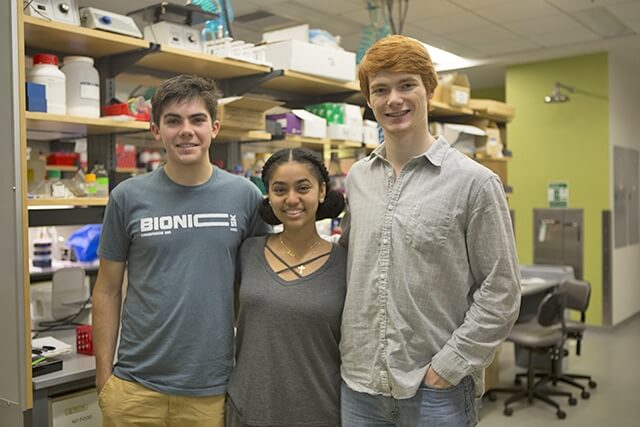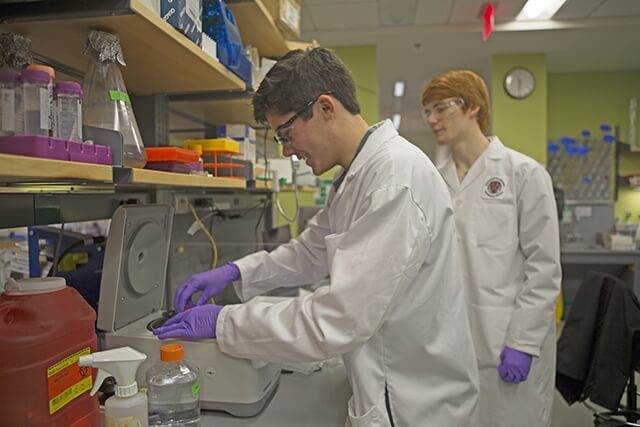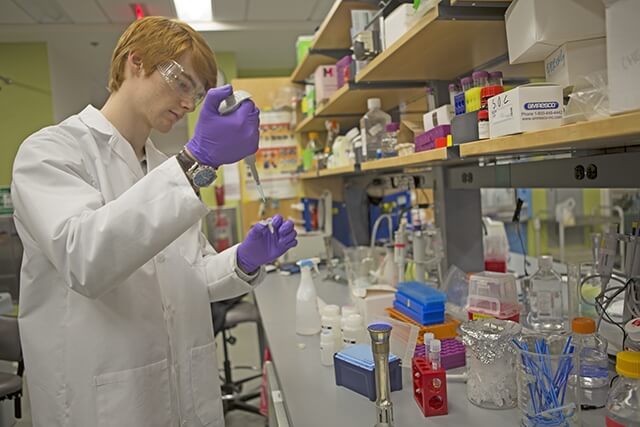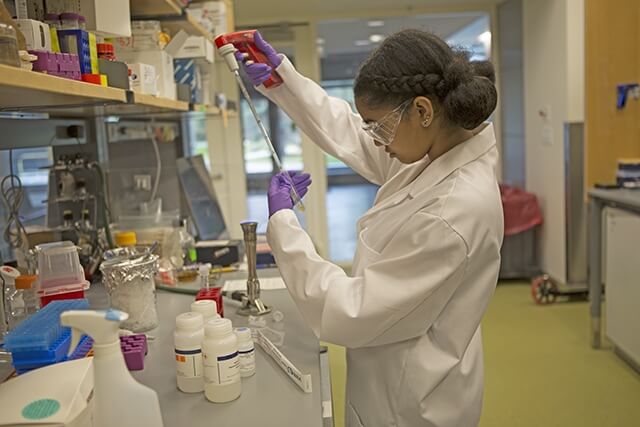News
For their iGEM project, team members (from left) Teagan Stedman, S.B. ’22, a bioengineering concentrator, Rahel Imru, A.B. ’21, a biomedical engineering concentrator, and Patrick Dickinson, A.B. ’22, an applied math concentrator used receptors that exist within the walls of human blood vessels to detect shear stress. (Photo by Adam Zewe/SEAS Communications)
In the battle against heart disease, more than 400,000 coronary artery bypass grafting surgeries are performed in the U.S. each year.
While veins from a patient’s leg are often used in the surgical procedure, tissue-engineered vascular grafts (TEVG), which are grown outside the body using a patient’s endothelial cells, are proving to be an effective and increasingly popular technique.
The most common reasons for TEVG failure are conditions like blood clots, narrowing of the blood vessels, and atherosclerosis. But what if these grafts could be engineered to detect and even prevent those ailments from occurring?
A team of Harvard John A. Paulson School of Engineering and Applied Sciences students set out to answer that question for their project in this year’s International Genetically Engineered Machine Competition. The project, dubbed FlowGlo, seeks to use receptors that exist within the walls of human blood vessels to detect shear stress, a warning sign that a blood vessel may be narrowing.
Teagan Stedman works on the team's iGEM project. (Photo by Adam Zewe/SEAS Communications)
“Shear stress is important to detect because it is a marker of a lot of different cardiovascular diseases. When there is narrowing of a blood vessel due to a blood clot, shear stress jumps exponentially, maybe up to 10 times its normal level,” said Teagan Stedman, S.B. ’22, a bioengineering concentrator. “Our idea is to link the activation of these receptors due to some level of shear stress to a modular response.”
Shear stress is a function of viscosity and how rapidly different layers of fluid are flowing over each other through a blood vessel. Because the walls of the vessel must move and roll with the strain of blood flow, receptors naturally activate at different levels of shear stress.
For instance, when shear stress rises above 4 Pascals, channels open in one specific protein receptor, Piezo1, and calcium ions enter the cell, signaling the activation. The students engineered Piezo 1 and two other protein receptors to present different colored fluorescent proteins when that activation occurs.
Harvard iGEM team member Patrick Dickinson said their work could someday help lead to improved treatments to break up blood clots. (Photo by Adam Zewe/SEAS Communications)
“Down the road, instead of using a fluorescent protein, you could possibly swap it out so the cells secrete some kind of clot busting protein to break up the clot and treat it on site,” said Patrick Dickinson, A.B. ’22, an applied math concentrator. “Current clot-busting medication is delivered through an IV, and it is system-wide and much less targeted, so there are greater risks for side effects. We think this could be a more targeted treatment in the long run.”
As part of their project, the team gathered feedback from Elena Aikawa, Professor of Medicine at the Harvard Medical School and Director of the Vascular Biology Program at Brigham and Women’s Hospital, who studies tissue-engineered vascular grafts. They also conducted a survey to better understand public perception of genetic engineering ethics, since their technique would require engineered cells to be implanted in the human body.
As they gathered qualitative data, they worked long hours in the lab on intricate experiments. Since beginning the project this summer, the teammates overcame many challenges caused by the difficulty of cloning cells. Relying on the support of their mentor, Timothy Chang, a postdoctoral fellow in the lab of Pamela Silver at the Harvard Medical School, they brainstormed, troubleshot, and learned volumes about synthetic biology along the way.
“I learned that biology is messy,” Dickinson said. “In a lab setting, there is a lot that is hard to predict. We certainly encountered a lot of frustration and stress along the way, but it was a good window into what research really is.”
Working on the Harvard iGEM team was the first lab experience for Rahel Imru. (Photo by Adam Zewe/SEAS Communications)
Now that the competition has concluded, the team’s work will be included in the iGEM Registry of Standard Biological Parts, a repository of genetic parts that can be mixed and matched to build synthetic biology devices and systems.
For Rahel Imru, it is gratifying to know that future iGEM teams and research groups from around the world could someday build off the research she and her peers have done.
While the weeks leading up to the competition were a whirlwind, the experience was well worth the effort, said Imru, A.B. ’21, a biomedical engineering concentrator.
“This was my first lab experience, so I definitely learned a lot,” she said. “I look back and see how much we’ve grown. Maybe we didn’t get all the data and results we wanted to by the end, but for the size of our team and the time that we had, seeing what we are able to accomplish is especially rewarding.”
Topics: Bioengineering
Cutting-edge science delivered direct to your inbox.
Join the Harvard SEAS mailing list.
Press Contact
Adam Zewe | 617-496-5878 | azewe@seas.harvard.edu






